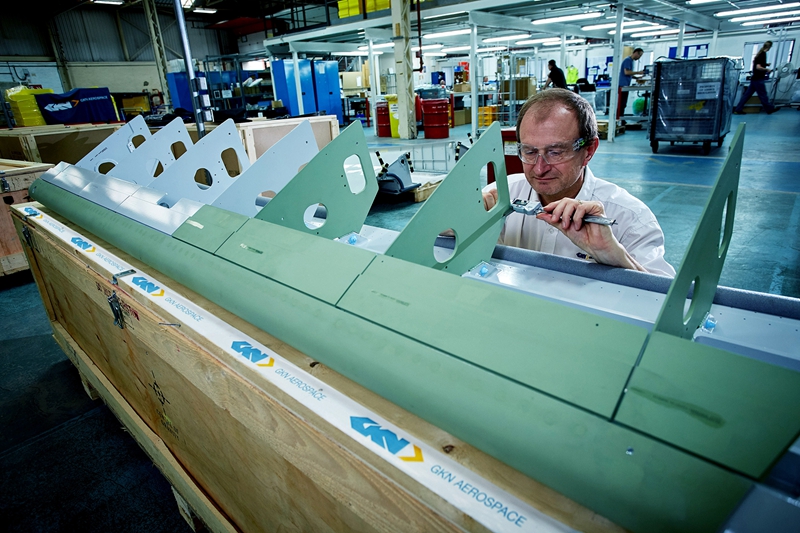 吉凯恩航宇的创新机翼前缘总成,已交付给空客的清洁蓝天BLADE项目。
吉凯恩航宇的创新机翼前缘总成,已交付给空客的清洁蓝天BLADE项目。 Clean Sky的SFWA项目中生产的创新机翼前缘复合夹板,图为地面展示阶段的产品。
Clean Sky的SFWA项目中生产的创新机翼前缘复合夹板,图为地面展示阶段的产品。
今年初,吉凯恩航宇(GKN Aerospace)公司表示,已经向一个大型研究项目交付了公司研发的机翼元件。该项目会在一架测试飞机的机翼上进行试验,测试与测量自然层流(NLF)设计的优势。据悉,欧洲的清洁天空(Clean Sky)智能固定翼飞机(Smart Fixed Wing Aircraft,下简称SWFA)计划旨在通过减少飞行阻力,降低下一代飞机的燃料消耗和尾气排放。该大型计划的经费50%来自欧盟,也同时获得了多方的参与和支持,吉凯恩参与的欧洲突破性层流翼验证机(Breakthrough Laminar Aircraft Demonstrator in Europe,下简称BLADE)项目也是该计划的一部分。
吉凯恩航宇公司高级工程技术副总裁Russ Dunn表示,“通过SFWA计划下的BLADE项目,我们可以推进有潜力的创新技术、概念和功能,进一步提升飞机的燃料经济性。”
吉凯恩航宇公司提供的关键机翼前缘总成和上盖,目前已经用于空客(Airbus)A340试飞机右翼的NLF翼截面。由于采用了全新的设计方法和创新制造技术,吉凯恩得以提供一种具有超高耐受性的特殊表面,从而达到NLF级别的性能表现。
在2017年的飞行试验中,该翼截面将承担测试NLF机翼结构性能与特点的任务,从而协助验证预期可以取得的经济和环境效益:根据预测,采用NLF机翼可以将飞机的飞行风阻降低8%,燃油经济性提升大约5%。
“无论能够带来多少空气动力学优势,设计与制造NLF机翼的关键挑战仍在于严格控制机翼的表面。”Dunn表示,“消除机翼表面的突起、缝隙、粗糙、不平整处,以及紧固件的接头至关重要,因为这些都会让飞机落入更加传统的‘湍流(turbulent flow)’性能级别。吉凯恩航宇的团队曾利用民用飞机项目中的结构设计和研发流程,打造了一批整合式共固化(co-cured)复合上盖,以及具有超高耐受性的机翼前缘表面。结果,我们的第一批零部件质量非常高,已经交付给飞行测试项目使用。”
几年前,为了基于地面演示(ground based demonstrator,简称GBD)而研发的机翼是一款面积为4.5 m x 1 m的机翼前缘。该前缘连接在部分机翼翼盒(partial wing box)之上,非常具有代表性。这种前缘设计可以将机翼分为两个区域,允许吉凯恩的工程师探索两种截然不同的设计哲学。
其中,“基础”部分采用了常见于绝大多数金属前缘的传统设计,即为翼肋增加了一层整体复合皮。而“创新”部分则采用了更加激进的设计,从而解决基础设计不能达到NLF级耐受性需求的问题。本部分采用了一款轻质前缘夹板,结合使用了电热机翼除冰保护(wing ice protection)技术、防腐蚀涂层,以及没有采用紧固件的外表面。
在Krueger创新设计中,团队还采用了增材制造工艺,打造机翼支撑结构,替代基础设计中的铝制翼肋。这样一来,仅需三根翼肋就能完成支撑前缘壁板的任务,分别为一根中央翼肋和二根端部翼肋。这样的设计能够确保机翼前缘可以在任何正常工作温度下,保持合理的空气动力学性能。与基础部分相比,创新部分使用的元件和紧固件数量更少,因此质量也更轻,可以极大地提高能效。
本项目由吉凯恩航宇的3个英国技术中心合作完成,分别为英国国家复合材料中心(National Composites Center)、位于卢顿的吉凯恩航宇,以及位于布里斯托尔的吉凯恩航宇增材制造中心。
作者:Jean L. Broge
来源:SAE 《航空航天工程》杂志
翻译:SAE 上海办公室
Innovative GKN wing structure contributes to Clean Sky next-gen aircraft
GKN Aerospace announced in January that it has delivered wing components as part of a major research program to test and measure the benefits of natural laminar flow (NLF) designs during trials on the wing of a flight test aircraft. The Breakthrough Laminar Aircraft Demonstrator in Europe (BLADE) project is part of the Clean Sky Smart Fixed Wing Aircraft (SWFA) program, an extensive, 50% European Union-funded, multi-partner activity aimed at lowering fuel consumption and emissions by reducing drag on next-generation.
“The SFWA BLADE program is allowing us to progress innovative technologies, concepts and capabilities with the potential to bring about a step change in aircraft fuel consumption,” said Russ Dunn, Senior Vice President, Engineering and Technology at GKN Aerospace.
GKN Aerospace has delivered the critical leading edge assemblies and upper covers that form part of the NLF wing section on the starboard wing of the Airbus A340 flight test aircraft. These structures offer NLF levels of performance through the adoption, by GKN Aerospace, of a totally new design approach and the application of novel manufacturing technologies that deliver the ultra-high tolerances and exceptional surface finish required.
During flight tests, taking place in 2017, this wing section will be used to test the performance characteristics of NLF wing architecture, helping prove predicted economic and environmental benefits: An NLF wing is expected to reduce wing drag by 8% and improve fuel consumption by approaching 5%.
“The key challenge with designing and manufacturing an NLF wing, with the many aerodynamic benefits that promises, stems from the need to tightly control the wing surface,” said Dunn.“It is vital to eliminate features such as steps, gaps, surface roughness and waviness or fastener heads as these all lead to more traditional ‘turbulent flow’ performance levels. The GKN Aerospace team has created these integrated, co-cured composite upper covers and very high tolerance leading edge surfaces using the same structured design and development process applied in commercial aircraft programs. As a result, our first part was of very high quality and has been delivered for the flight test program.”
The ground based demonstrator (GBD) of the wing developed a couple years ago was a 4.5 m x 1 m section of flight-representative wing leading edge attached to a partial wing box assembly. The leading edge accommodated a Krueger flap in two sections, which allowed GKN engineers to investigate two very different design philosophies.
The first "baseline" section applied a monolithic composite skin to the traditional rib design seen on the majority of metallic leading edges today. The second "innovative" section applied a more radical design to address issues experienced meeting NLF tolerances with the baseline design. This section comprised a lightweight leading edge sandwich panel incorporating electro-thermal wing ice protection technology with an integrated erosion shield and fastener-free outer surface.
Additive manufacturing processes were used to create a novel support structure for the Krueger mechanism, replacing the aluminum ribs in the baseline design. This allowed the leading edge panel to be supported by just three composite ribs: a single central rib and two closing ribs. These maintain the correct leading edge aerodynamic profile over the complete range of operating temperatures. The innovative section had a lower component and fastener count, was significantly lighter, and had greatly improved performance predictions compared to the baseline section.
The overall project was a collaboration between three GKN Aerospace technology centres in the U.K.: a team at the U.K.’s National Composites Center, at GKN Aerospace in Luton, and at the GKN Aerospace additive manufacturing center in Bristol.
Author: Jean L. Broge
Source: SAE Aerospace Engineering Magazine
等级
打分
- 2分
- 4分
- 6分
- 8分
- 10分
平均分
- 作者:Jean L. Broge
- 行业:航空
- 主题:噪声、振动与声振粗糙度质量、可靠性与耐久性运输系统车辆与性能车身/机身与架构工程设计与造型测试与检验
